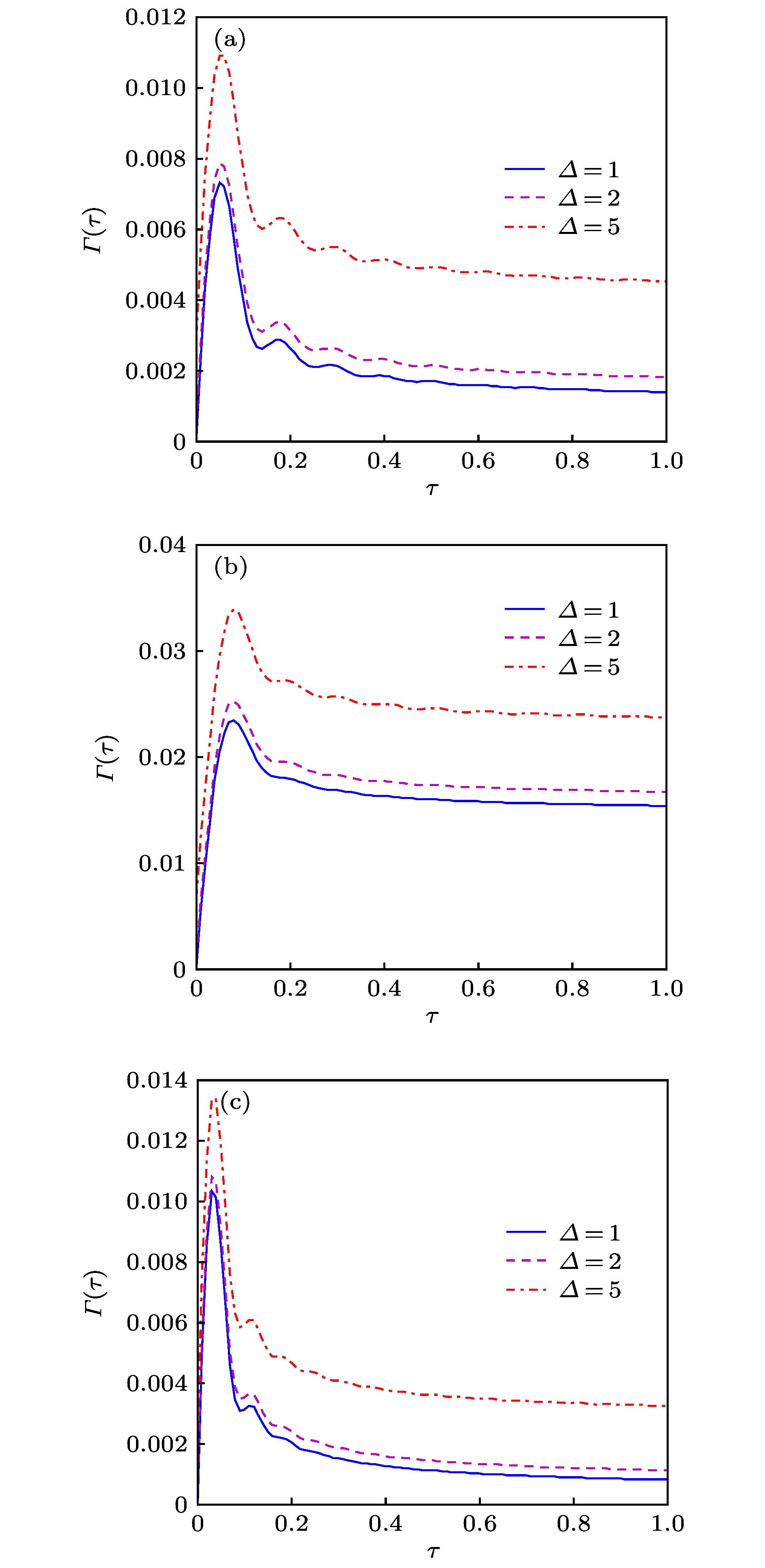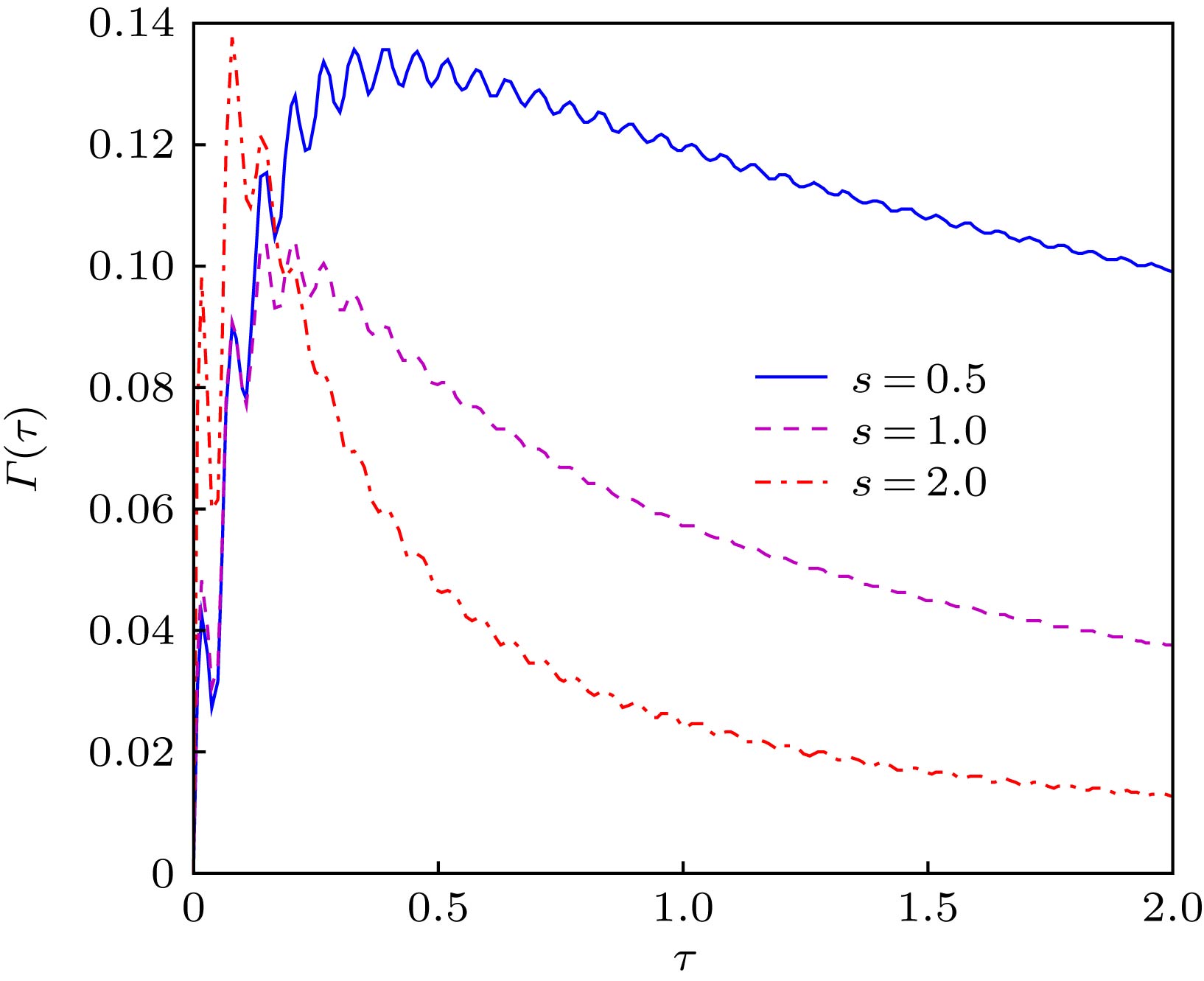-
The quantum system decay can be frozen and slowed down when it is repeatedly and frequently measured, which is described as the quantum Zeno effect (QZE). On the other hand, the evolution of the quantum system can be sped up if the measurement is not frequent enough, which is called quantum anti-Zeno effect (QAZE). Both the QZE and QAZE have been experimentally observed in many different physical setups, and have attracted tremendous theoretical and experimental interest due to their significant potential applications in quantum information processing. A recent research has demonstrated that the effective lifetime of the quantum system when being measured repeatedly depends on the spectral density of the environment, the system parameters, and the system-environment coupling. Then, how to prolong the survival time of the quantum system subjected to being repeatedly measured is an issue that deserves to be studied. In the present paper, considered is a classical-field-driven two-level system interacting with a bosonic reservoir at zero temperature. We investigate the dynamics of the effective decay rate versus the measurement interval, and propose a scheme to prolong the lifetime of the quantum system subjected to being measured repeatedly, with a classical field driven. The results show that when the initial state of the quantum system is excited, QZE-to-QAZE transitions occurs several times. In an identical time interval, the decay rate for the initial superposition state is far smaller than that for the initial excited state. More importantly, the effective decay rate is very small when the classical driving is strong enough, which indicates that the classical driving can improve the survival probability of the two-level system subjected to being measured frequently and repeatedly. In addition, the environmental ohmicity plays an important role in keeping the quantum state alive. The detuning between the two-level system and the classical field has an adverse effect on the decay rate. In other words, the survival probability decreases as the detuning increases. Fortunately, this negative influence from the detuning can be suppressed by increasing the strength of classical driving or choosing the appropriate ohmicity parameter of the environment. -
Keywords:
- quantum Zeno effect /
- classical driving /
- effective decay rate /
- survival probability
[1] Maniscalco S, Francica F, Zaffino R L, Gullo N L, Plastina F 2008 Phys. Rev. Lett. 100 090503
 Google Scholar
Google Scholar
[2] Bernu J, Deléglise S, Sayrin C, Kuhr S, Dotsenko I, Brune M, Raimond J M, Haroche S 2008 Phys. Rev. Lett. 101 180402
 Google Scholar
Google Scholar
[3] Facchi P, Lidar D A, Pascazio S 2004 Phys. Rev. A 69 032314
 Google Scholar
Google Scholar
[4] Schlosshauer M 2018 Phys. Rev. A 97 042104
 Google Scholar
Google Scholar
[5] Christensen C N, Iles-Smith J, Petersen T S, Mǿrk J, McCutcheon D P S 2018 Phys. Rev. A 97 063807
 Google Scholar
Google Scholar
[6] Cao Y, Li Y H, Cao Z, Yin J, Chen Y A, Yin H L, Chen T Y, Ma X, Peng C Z, Pan J W 2017 PNAS 114 4920
 Google Scholar
Google Scholar
[7] Kiilerich A H, Mǿlmer K 2015 Phys. Rev. A 92 032124
 Google Scholar
Google Scholar
[8] Fischer M C, Gutiérrez-Medina B, Raizen M G 2001 Phys. Rev. Lett. 87 040402
 Google Scholar
Google Scholar
[9] Kakuyanagi K, Baba T, Matsuzaki Y, Nakano H, Saito S, Semba K 2015 New J. Phys. 17 063035
 Google Scholar
Google Scholar
[10] Chen P W, Tsai D B, Bennett P 2010 Phys. Rev. B 81 115307
 Google Scholar
Google Scholar
[11] 石永强, 孔维龙, 吴仁存, 张文轩, 谭磊 2017 物理学报 66 054204
 Google Scholar
Google Scholar
Shi Y Q, Kong W L, Wu R C, Zhang W X, Tan L 2017 Acta Phys. Sin. 66 054204
 Google Scholar
Google Scholar
[12] Zhang M C, Wu W, He L Z, Xie Y, Wu C W, Li Q, Chen P X 2018 Chin. Phys. B 27 090305
 Google Scholar
Google Scholar
[13] Hacohen-Gourgy S, Garcia-Pintos L P, Martin L S, Dressel J, Siddiqi I 2018 Phys. Rev. Lett. 120 020505
 Google Scholar
Google Scholar
[14] He S, Wang C, Ren X Z, Duan L W, Chen Q H 2019 https://arxiv.org/abs/1904.03872
[15] Nourmandipour A, Tavassoly M K, Bolorizadeh M A 2016 J. Opt. Soc. Am. B 33 1723
[16] Francica F, Maniscalco S, Plastina F 2010 Phys. Scr. T 140 014044
[17] Chaudhry A Z, Gong J 2014 Phys. Rev. A 90 012101
 Google Scholar
Google Scholar
[18] Aftab M J, Chaudhry A Z 2017 Sci. Rep. 7 11766
 Google Scholar
Google Scholar
[19] Majeed M, Chaudhry A Z 2018 Sci. Rep. 8 14887
 Google Scholar
Google Scholar
[20] Ozawa A, Davila-Rodriguez J, Hänsch T W, Udem T 2018 Sci Rep. 8 10643
 Google Scholar
Google Scholar
[21] Harrington P M, Monroe J T, Murch K W 2017 Phys. Rev. Lett. 118 240401
 Google Scholar
Google Scholar
[22] Zhou Z, Lü Z, Zheng H, Goan H S 2017 Phys. Rev. A 96 032101
 Google Scholar
Google Scholar
[23] Wu W, Lin H Q 2017 Phys. Rev. A 95 042132
 Google Scholar
Google Scholar
[24] Zhang J M, Jing J, Wang L G, Zhu S Y 2018 Phys. Rev. A 98 012135
 Google Scholar
Google Scholar
[25] Chaudhry A Z 2016 Sci. Rep. 6 29497
 Google Scholar
Google Scholar
[26] Chaudhry A Z 2017 Sci. Rep. 7 1741
 Google Scholar
Google Scholar
[27] Zhang J S, Xu J B, Lin Q 2009 Eur. Phys. J. D 51 283
 Google Scholar
Google Scholar
[28] Gao D Y, Gao Q, Xia Y J 2018 Chin. Phys. B 27 060304
 Google Scholar
Google Scholar
[29] Gao D Y, Gao Q, Xia Y J 2017 Chin. Phys. B 26 110303
 Google Scholar
Google Scholar
[30] Zhang Y J, Han W, Xia Y J, Cao J P, Fan H 2015 Phys. Rev. A 91 032112
 Google Scholar
Google Scholar
[31] Li Y L, Xiao X, Yao Y 2015 Phys. Rev. A 91 052105
 Google Scholar
Google Scholar
[32] Pinkse P W H, Fischer T, Maunz P, Rempe G 2000 Nature 404 365
 Google Scholar
Google Scholar
[33] Varcoe B T H, Brattke S, Weidinger M, Walther H 2000 Nature 403 743
 Google Scholar
Google Scholar
[34] Zhang M C, Wu C W, Xie Y, Wu W, Chen P X 2019 Quant. Inf. Process. 18 97
 Google Scholar
Google Scholar
[35] Hur K L 2012 Phys. Rev. B 85 140506(R)
 Google Scholar
Google Scholar
[36] Nagy D, Kónya G, Szirmai G, Domokos P 2010 Phys. Rev. Lett. 104 130401
 Google Scholar
Google Scholar
-
图 2 有效衰减率随测量间隔的变化曲线 (a)
$\varOmega = 30$ ,$s = 0.5$ ; (b)$\varOmega = 30$ ,$s = 2$ ; (c)$\varOmega = 50$ ,$s = 2$ Figure 2. The beehavior of the effective decay rate as a function of the measurement interval: (a)
$\varOmega = 30$ ,$s = 0.5$ ; (b)$\varOmega = 30$ ,$s = 2$ ; (c)$\varOmega = 50$ ,$s = 2$ . -
[1] Maniscalco S, Francica F, Zaffino R L, Gullo N L, Plastina F 2008 Phys. Rev. Lett. 100 090503
 Google Scholar
Google Scholar
[2] Bernu J, Deléglise S, Sayrin C, Kuhr S, Dotsenko I, Brune M, Raimond J M, Haroche S 2008 Phys. Rev. Lett. 101 180402
 Google Scholar
Google Scholar
[3] Facchi P, Lidar D A, Pascazio S 2004 Phys. Rev. A 69 032314
 Google Scholar
Google Scholar
[4] Schlosshauer M 2018 Phys. Rev. A 97 042104
 Google Scholar
Google Scholar
[5] Christensen C N, Iles-Smith J, Petersen T S, Mǿrk J, McCutcheon D P S 2018 Phys. Rev. A 97 063807
 Google Scholar
Google Scholar
[6] Cao Y, Li Y H, Cao Z, Yin J, Chen Y A, Yin H L, Chen T Y, Ma X, Peng C Z, Pan J W 2017 PNAS 114 4920
 Google Scholar
Google Scholar
[7] Kiilerich A H, Mǿlmer K 2015 Phys. Rev. A 92 032124
 Google Scholar
Google Scholar
[8] Fischer M C, Gutiérrez-Medina B, Raizen M G 2001 Phys. Rev. Lett. 87 040402
 Google Scholar
Google Scholar
[9] Kakuyanagi K, Baba T, Matsuzaki Y, Nakano H, Saito S, Semba K 2015 New J. Phys. 17 063035
 Google Scholar
Google Scholar
[10] Chen P W, Tsai D B, Bennett P 2010 Phys. Rev. B 81 115307
 Google Scholar
Google Scholar
[11] 石永强, 孔维龙, 吴仁存, 张文轩, 谭磊 2017 物理学报 66 054204
 Google Scholar
Google Scholar
Shi Y Q, Kong W L, Wu R C, Zhang W X, Tan L 2017 Acta Phys. Sin. 66 054204
 Google Scholar
Google Scholar
[12] Zhang M C, Wu W, He L Z, Xie Y, Wu C W, Li Q, Chen P X 2018 Chin. Phys. B 27 090305
 Google Scholar
Google Scholar
[13] Hacohen-Gourgy S, Garcia-Pintos L P, Martin L S, Dressel J, Siddiqi I 2018 Phys. Rev. Lett. 120 020505
 Google Scholar
Google Scholar
[14] He S, Wang C, Ren X Z, Duan L W, Chen Q H 2019 https://arxiv.org/abs/1904.03872
[15] Nourmandipour A, Tavassoly M K, Bolorizadeh M A 2016 J. Opt. Soc. Am. B 33 1723
[16] Francica F, Maniscalco S, Plastina F 2010 Phys. Scr. T 140 014044
[17] Chaudhry A Z, Gong J 2014 Phys. Rev. A 90 012101
 Google Scholar
Google Scholar
[18] Aftab M J, Chaudhry A Z 2017 Sci. Rep. 7 11766
 Google Scholar
Google Scholar
[19] Majeed M, Chaudhry A Z 2018 Sci. Rep. 8 14887
 Google Scholar
Google Scholar
[20] Ozawa A, Davila-Rodriguez J, Hänsch T W, Udem T 2018 Sci Rep. 8 10643
 Google Scholar
Google Scholar
[21] Harrington P M, Monroe J T, Murch K W 2017 Phys. Rev. Lett. 118 240401
 Google Scholar
Google Scholar
[22] Zhou Z, Lü Z, Zheng H, Goan H S 2017 Phys. Rev. A 96 032101
 Google Scholar
Google Scholar
[23] Wu W, Lin H Q 2017 Phys. Rev. A 95 042132
 Google Scholar
Google Scholar
[24] Zhang J M, Jing J, Wang L G, Zhu S Y 2018 Phys. Rev. A 98 012135
 Google Scholar
Google Scholar
[25] Chaudhry A Z 2016 Sci. Rep. 6 29497
 Google Scholar
Google Scholar
[26] Chaudhry A Z 2017 Sci. Rep. 7 1741
 Google Scholar
Google Scholar
[27] Zhang J S, Xu J B, Lin Q 2009 Eur. Phys. J. D 51 283
 Google Scholar
Google Scholar
[28] Gao D Y, Gao Q, Xia Y J 2018 Chin. Phys. B 27 060304
 Google Scholar
Google Scholar
[29] Gao D Y, Gao Q, Xia Y J 2017 Chin. Phys. B 26 110303
 Google Scholar
Google Scholar
[30] Zhang Y J, Han W, Xia Y J, Cao J P, Fan H 2015 Phys. Rev. A 91 032112
 Google Scholar
Google Scholar
[31] Li Y L, Xiao X, Yao Y 2015 Phys. Rev. A 91 052105
 Google Scholar
Google Scholar
[32] Pinkse P W H, Fischer T, Maunz P, Rempe G 2000 Nature 404 365
 Google Scholar
Google Scholar
[33] Varcoe B T H, Brattke S, Weidinger M, Walther H 2000 Nature 403 743
 Google Scholar
Google Scholar
[34] Zhang M C, Wu C W, Xie Y, Wu W, Chen P X 2019 Quant. Inf. Process. 18 97
 Google Scholar
Google Scholar
[35] Hur K L 2012 Phys. Rev. B 85 140506(R)
 Google Scholar
Google Scholar
[36] Nagy D, Kónya G, Szirmai G, Domokos P 2010 Phys. Rev. Lett. 104 130401
 Google Scholar
Google Scholar
Catalog
Metrics
- Abstract views: 11050
- PDF Downloads: 78
- Cited By: 0





















 DownLoad:
DownLoad:
















